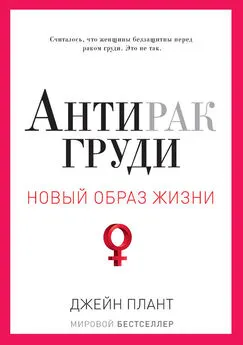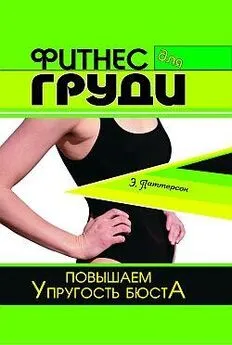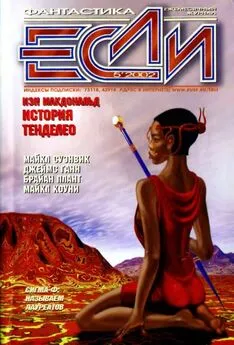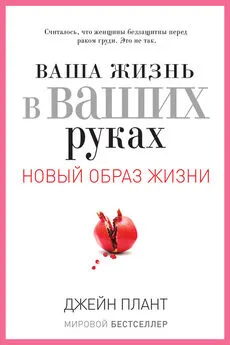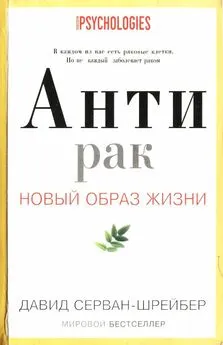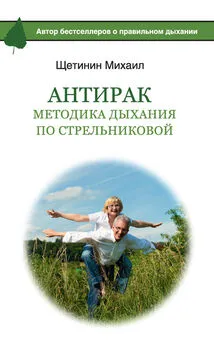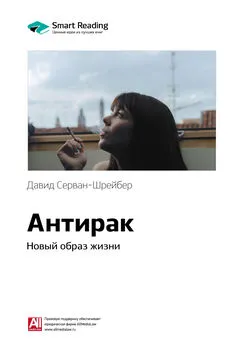Джейн Плант - Антирак груди
- Название:Антирак груди
- Автор:
- Жанр:
- Издательство:Рипол классик
- Год:2015
- Город:Москва
- ISBN:978-5-386-08504-9
- Рейтинг:
- Избранное:Добавить в избранное
-
Отзывы:
-
Ваша оценка:
Джейн Плант - Антирак груди краткое содержание
Рак груди – непонятная и пугающая тема. Суровые факты шокируют: основная причина смерти женщин от 25 до 75 лет – различные формы рака, и рак молочной железы – один из самых смертоносных. Это современное бедствие уже приобрело характер эпидемии. Но книга «Антирак груди» написана не для того, чтобы вы боялись. Напротив, это история о надежде.
Пройдя путь от постановки страшного диагноза к полному выздоровлению, профессор Плант на собственном опыте познала все этапы онкологического лечения, изучила глубинные причины возникновения рака груди и составила программу преодоления и профилактики этого страшного заболевания. Благодаря десяти факторам питания и десяти факторам образа жизни от Джейн Плант ваша жизнь действительно будет в ваших руках.
Книга также издавалась под названием «Ваша жизнь в ваших руках. Как понять, победить и предотвратить рак груди и яичников».
Антирак груди - читать онлайн бесплатно ознакомительный отрывок
Интервал:
Закладка:
New Scientist , August 2006.
684
Следуйте инструкциям изготовителя и не превышайте рекомендуемую дозу. Качество таблеток или жиров зависит от фирмы-производителя.
685
Следуйте инструкциям изготовителя и не превышайте рекомендуемую дозу. Качество таблеток или жиров зависит от фирмы-производителя.
686
Следуйте инструкциям изготовителя и не превышайте рекомендуемую дозу. Качество таблеток или жиров зависит от фирмы-производителя.
687
Anon. 2003. Growing problems: Endocrine disruptors under the spotlight. ENDS Report , 336, 20–23.
688
Vikse, R. and others, 1999. Heterocyclic amines in cooked meat. Tidsskr Nor Laegeforen , 119 (1), 45–49.
689
Skog, K. and others, 1997. Polar and non-polar heterocyclic amines in cooked fi sh and meat products and their corresponding pan residues. Food Chemical Toxicology , 35 (6), 555–565.
690
BMJ , 325, 1250.
691
JAMA , 1985, 254 (3), 356–357.
692
JIFSTAN/NCFST Acrylamide in Food Workshop, 1989. White paper for Working Group 5: Risk Communication. National Research Council, National Academy of Sciences (NRC-NAS). Improving Risk Communication . National Academy Press. Washington DC.
693
Fleck, Fiona, 2002. Experts launch action on staple foods. BMJ , 325, 120; Anon. 2002. Acrylamide dues found in Asparagine. ICON , 1 (6), 24.
694
US Environmental Protection Agency, http://www.epa.gov/ttn/atw/hlthef/acrylami.html
695
http://ntp-server.niehs.nih.gov/htdocs/Chem_H&S/NTP_Chem7/Radian79-06-1.html
696
http://www.nsc.org/library/chemical/Acrylami.htm
697
Anon. 1997. Acrylamide. Toxic Air Contaminant Identifi cation. List Summaries – ARB/SSD/SES. September 1997.
698
Advisory Committee on Hazardous Substances. Sixth Annual Report (2001–2002). Department for Environment, Food and Rural Affairs; The Royal Commission on Environmental Pollution, 2003. Chemicals in products: safeguarding the environment and human health. Report 24.
699
US Environmental Protection Agency, http://www.epa.gov/ttn/atw/hlthef/acrylami.html
700
http://ntp-server.niehs.nih.gov/htdocs/Chem_H&S/NTP_Chemy/Radian79-06-1.html
701
http://www.foodstandards.gov.uk/mi3ltimedia/webpage/acrylamide_study_faq
702
www.cancerresearchuk.org
703
White, Craig A. and Macleod, Una, 2002. ABC of psychological medicine: Cancer. BMJ , 325, 377–380.
704
Walsh, Kiri, King, Michael, Jones, Louise, Tookman, Adrian and Blizzard, Robert, 2002. Spiritual beliefs may affect outcome of bereavement: prospective study. BMJ , 324, 1551–1554.
705
White, Craig A. and Macleod, Una, 2002. ABC of psychological medicine: Cancer. BMJ , 325, 377–380.
706
White, Craig A. and Macleod, Una, 2002. ABC of psychological medicine: Cancer. BMJ , 325, 377–380.
707
White, Craig A. and Macleod, Una, 2002. ABC of psychological medicine: Cancer. BMJ , 325, 377–380.
708
Petticrew, Mark, Bell, Ruth and Hunter, Duncan, 2002. Influence of psychological coping on survival and recurrence in people with cancer: systematic review. BMJ , 325, 1066–1069.
709
Graham, J, Ramirez, A, Love, S, Richards, M and Burgess, C. 2002. Stressful life experiences and risk of relapse of breast cancer: observational cohort study. BMJ , 324, 1420–1422.
710
Beales, D., 2004. Beyond mind-body dualism: implications for patient care. Journal of Holistic Healthcare , 1 (3).
711
Ernst, Edzard (ed.), 2001. The desktop guide to complementary and alternative medicine. Mosby.
712
King, Michael and five others, 2002. Effectiveness of teaching general practitioners skills in brief cognitive behaviour therapy to treat patients with depression: randomised controlled trial. BMJ , 324, 947.
713
http://www.nccn.org/patient_gls/_english/_prostate/
714
European Journal of Cancer , 2003, 39, 1562–1567; quoted in BMJ , 327, 402.
715
Plant, Jane and Stephenson, Janet, in preparation. Breakthrough Anxiety and Depression .
716
Bartram, Thomas, 1998. Bartram's Encyclopedia of Herbal Medicine . London: Robinson.
717
Miller, G H, 1996. Can Active or Passive Smoking Increase Breast Cancer Mortality? Cancer Detect Prevent 20 (5).
718
Mayor, Susan. 2002. Pregnancy and early smoking increases breast cancer risk. BMJ , 325, 12 October 2002, 793.
719
Cancer Epidemiology, Biomarkers and Prevention , July 2003; http://www.nlm.nih.gov/medlineplus/news/fullstory_13352.html
720
Plant, Jane and Tidey, Gill, 2003. Understanding, preventing and overcoming osteoporosis . Virgin Books.
721
Goodman-Gruen, D. and Barrett-Connor, E., 1997. Epidemiology of insulin-like growth factor-I in elderly men and women. The Rancho Bernardo Study. American Journal of Epidemiology , 145, 970–976; Kaklamani, V.G., Linos, A., Kaklamani E., Markaki, I. and Mantzoros, C., 1999. Age, sex, and smoking are predictors of circulating insulin-like growth factor 1 and insulin-like growth factor-binding protein 3. Journal of Clinical Oncology , 17. 813–817.
722
Colborn, T., Dumanoski, D. and Myers, J.P., 1996. Our Stolen Futures , Dutton, Penguin Books, USA.
723
The Environment Agency, March 2000. Endocrine-disrupting substances in the environment: The Environment Agency's Strategy, The Environment Agency, Bristol, UK.
724
Алармистка (от англ. alarm – тревога, сигнал опасности, сигнал тревоги) – распространительница тревожных (обычно необоснованных) слухов. – Примеч. ред.
725
Miller, W.R. and Sharpe, R.M., 1998. Environmental oestrogens and human reproductive cancers. Endocrine-Related Cancer , S, 69–96; Plant, J.A. and Davis, D.L., 2003. Breast and prostate cancer: sources and pathways of endocrine-disrupting chemicals (EDCs). In Geology and Health . Skinner, H.C.W. and Berger, A.R. (editors). OUP. 95–99.
726
McKinlay, R. and others, in press. Endocrine disrupting pesticides: implications for risk assessment.
727
Toppari, J., Larsen, J.C., Christiansen, P., Giwercman, A., Grandjean, P., Guillette, L-J., Jr, Jegou, B., Jensen, T.K., Jouannet, P., Keiding, N., Leffers, H., McLachlan, J.A., Meyer, O., Muller, J., Rajpert-De Meyts, E., Scheike, T., Sharpe, R.M., Sumpter, J.S., and Skakkebaek, N.E., 1996. Male reproductive health and environmental xenoestrogens. Environmental Health Perspectives , 104, 741–803.
728
www.cancersupportinternational.com
729
The Royal Commission on Environmental Pollution, 2003. Chemicals in products: safeguarding the environment and human health. Report 24; Annual Reports of the (UK) Chemical Stakeholders Forum, 2002, and The Advisory Committee on Hazardous Substances, 2002; Miller, W.R. And Sharpe, P.M., 1998. Environmental oestrogens and human reproductive cancers. Endocrine-Related Cancer , 5, 69–96.
730
Charlier, C.C.J., 2002. Determination of organochlorine pesticide residues in the blood of healthy individuals. Clinical Chemistry and Laboratory Medicine , 44, 361–364; WWF, 2003. UK national biomonitoring survey . WWF.
731
MDuffie, H.H., 2005. Host factors and genetic susceptibility: a paradigm of the conundrum of pesticide exposure and cancer associations. Reviews on Environmental Health . 20 (2), 77-101.
732
Mathur, V., 2002. Breast cancer incidence and exposure to pesticides among women originating from Jaipur. Environment International , 28 (5), 331–336; Starek, A., 2003. Estrogen and organochlorine xenoestrogens and breast cancer risk. International Journal of Occupational Medicine and Environmental Health . 16 (2), 113–124.
733
Frigo, D.E., 2004. Mechanism of AP-1-mediated gene expression by select organochlorines through the p38 MAPK pathway. Carcinogenesis , 25 (Feb), 249–261; Lewis, J.S. and others, 2005. Differential effects of 16-hydroxyestrone and 2-methoxyestradiol on cyclin D1 involving the transcription factor ATF-2 in MCF-7 breast cancer cells. Journal of Molecular Endocrinology , 34, 91-105; Tessier, D.D., 2001. Increased ErbB-2 tyrosinekinase activity, MAPK phosporylation, and cell proliferation in the prostate cancer cell line LNCaP following treatment by select pesticides. Toxicological Sciences . 60 (1), 38–43.
734
Swan S.H. and others, 2005. Decrease in anogenital distance among male infants with prenatal phthalate exposure. Environmental Health Perspectives , 113, (8).
735
Kawauchi, H., 2002. Identifi cation of growth hormone in the sea lamprey, an extant representative of a group of the most ancient vertebrates. Endocrinology , 143 (12), 4916–4921; Park, J.I., 2005. Conservation of the heterodimeric glycoprotein hormone subunit family proteins and the LGR signalling system from nematodes to humans. Endocrine Journal , 26 (3), 267–276.
736
Environmental Endocrine Disruptors: A Handbook of Property Data, John Wiley and Sons.
737
Edwards, T.T., 2006. Reproductive dysgenesis in wildlife: a comparative view. International Journal of Andrology , 29 (1), 109–121; Guillette, L.L., 1999. Plasma steroid concentrations and male phallus size in juvenile alligators from seven Florida lakes. General and Comparative Endocrinology , 116(3), 356–372.
738
Colborn, T., Dumanoski, D. and Myers, J.P., 1996. Our Stolen Futures , Dutton, Penguin Books, USA.
739
Webb, S.F., 2000. Risk assessment approaches for Pharmaceuticals. In: International Seminar: Pharmaceuticals in the Environment, Technological Institute, Section on Environmental Technology, Brussels, 2000.
Читать дальшеИнтервал:
Закладка:
